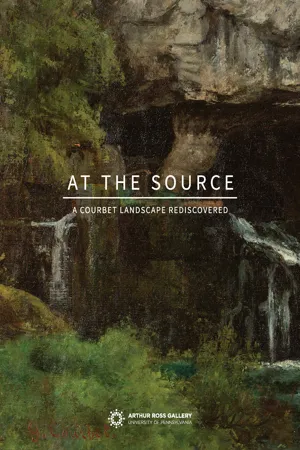
At the Source
A Courbet Landscape Rediscovered
- 130 pages
- English
- PDF
- Available on iOS & Android
At the Source
A Courbet Landscape Rediscovered
About this book
In 2016, a landscape painting of the source of the Lison river in France was discovered at the University of Pennsylvania and was immediately suspected of being the work of Gustave Courbet. A lengthy authentication process began in 2018 and the landscape has since been confirmed as his. This new discovery sparked an exhibition showcasing the infamous painter's modern landscape practice. Titled At the Source: A Courbet Landscape Rediscovered, the exhibition is presented at the University of Pennsylvania's Arthur Ross Gallery from February 4 to May 28, 2023. Focusing on the motifs of grottos and waterfalls in his art of the 1850s and 1860s, it highlights the rediscovered Courbet painting, not shown in public for close to 100 years, and emphasizes the process of authenticating and conserving this historic work.Gustave Courbet (1819–1877) was a French painter who led the Realism movement of the mid nineteenth-century. Committed to painting only what he could see, he rejected academic conventions and the Romanticism of the previous generation of artists. Courbet's paintings of the late 1840s and early 1850s brought him his first recognition. They challenged tradition by depicting unidealized peasants and workers, often on a grand scale previously reserved for paintings of religious or historical subjects. Courbet's subsequent paintings offer a wide range of genres and broadened the political character of his art: landscapes, seascapes, hunting scenes, nudes, and still lifes.This heavily illustrated catalog brings together essays by leading Courbet scholars, including Petra ten-Doesschate Chu, Aruna D'Souza, Paul Galvez, and Mary Morton, and situates Courbet's modern landscapes within the genre of nineteenth-century plein-air painting. Contextualizing the newly discovered work in relation to other visual depictions of the site, the catalog reproduces postcards and maps as well as the few other versions of the Source of the Lison that Courbet painted, including other related subjects. The essays draw connections between Courbet's paintings and his political activism, his interests in geology and environmentalism, and his engagement with issues of gender.
Frequently asked questions
- Essential is ideal for learners and professionals who enjoy exploring a wide range of subjects. Access the Essential Library with 800,000+ trusted titles and best-sellers across business, personal growth, and the humanities. Includes unlimited reading time and Standard Read Aloud voice.
- Complete: Perfect for advanced learners and researchers needing full, unrestricted access. Unlock 1.4M+ books across hundreds of subjects, including academic and specialized titles. The Complete Plan also includes advanced features like Premium Read Aloud and Research Assistant.
Please note we cannot support devices running on iOS 13 and Android 7 or earlier. Learn more about using the app.
Information
Table of contents
- Cover
- Title Page
- Copyright
- Contents
- Foreword
- Acknowledgments
- Introduction
- Thomas W. Evans: A Gilded Life and Legacy
- Courbet and the Source of the Lison: Geological Curiosity, Industrial Power Source, and “Natural Site of an Artistic Character”
- Of Sources and Salt
- Courbet Painting in Nature
- Paths to the Source: The Lison and Nineteenth-Century Tourism
- Source, Origin, Endpoint, Projection, Possession
- Displays of Power: Courbet as Exhibition Maker
- Courbet, or Not Courbet, That Is the Question
- Unsettled Ground: The Development of Courbet Landscape Studies
- Pigment Analysis of a Landscape by Gustave Courbet
- Courbet in Context
- Exhibition Checklist
- Further Reading
- Contributors
- Photography Credits